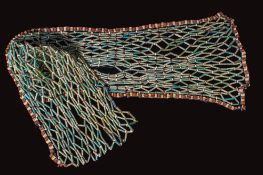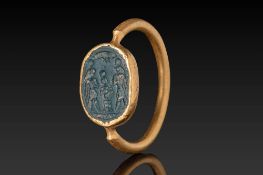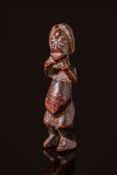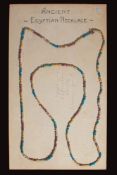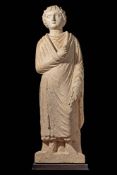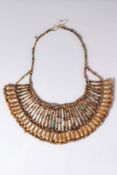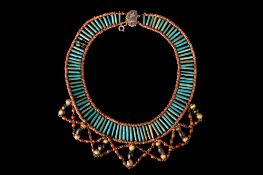Ca. AD 600. A gold cross pendant composed of four circular cells joined around a central fifth cell, each bordered with a ring of granulation and...
*
Sortieren nach:
- Nur Lose mit Abbildungen,
- Auktionshaus
- Liste
- Galerie
-
909 Los(e)/Seite
New Kingdom to Late Period, Ca. 1550 - 332 BC. A funerary bead net made from faience tubular beads interspersed with small rings in varying shade...
Ca. 450 BC. A terracotta skyphos with a deep, slightly flaring body, a flat base, and two horizontally extending handles positioned at the upper s...
ROMAN GLASS SPRINKLER
Ca. AD 300. A pale green glass sprinkler with an apple-shaped body, short cylindrical neck, and a broad, inward-folded rim. The neck is constricte...
Ca. 332 BC - AD 200. A small blue-glazed ceramic vessel and an amulet, both modelled in the form of corn ears. The vessel is topped with a short,...
Ca. 600 - 300 BC. A green chalcedony intaglio engraved with a triad of Egyptian deities standing frontally, each surmounted by a solar disc. The ...
New Kingdom to Late Period, Ca. 1550 - 332 BC. A collection of restrung necklaces and strands composed of faience beads in a variety of shapes an...
Ca. 350 - 300 BC. A pair of wheel-thrown terracotta oinochoai, each with a piriform body, trefoil mouth, and high-arched handle, covered in a bla...
Ca. AD 1 - 200. An oval red carnelian intaglio engraved with a gryllos composed of a bird-like figure with an elongated neck and head held high, ...
Ca. AD 1 - 200. A collection of five glass vessels. The first vessel on the left has a pear-shaped body and a tall, cylindrical neck terminating i...
LARGE DAUNIAN JUG WITH RED BANDS
Ca. 550 BC. A large terracotta jug with ovoid body, sloping neck, pronounced mouth and single arching strap handle, decorated in ochre with horiz...
Ca. AD 200 - 400. A silver figurine of an eagle with wings folded along the back and body, perched on a rectangular base. The head is rounded wit...
Ca. 500 - 300 BC. A gold pendant of circular form with a raised central boss encircled by a concentric band, bordered by a ring of evenly spaced ...
Ca. AD 1 - 200. A silver ring with a broad, flat oval bezel and a narrow hoop that widens smoothly at the shoulders. The bezel is engraved with a...
Ca. 400 - 300 BC. A rare askos with a globular body, cylindrical neck, and a pair of horizontal handles at the midsection. Two vertical spouts ri...
EASTERN GREEK SILVER PHIALE
Ca. 500 - 300 BC. A silver phiale with a shallow, wide body and a slightly convex base. The gently flaring rim extends outward, forming a broad li...
GREEK BRONZE RING WITH BUCRANIUM
Ca. 300 BC. A bronze ring with a pointed oval bezel engraved with a bucranium, a stylised frontal depiction of an ox skull. The hoop is circular ...
Early Ptolemaic Period, Ca. 304 - 200 BC. A black schist stele (cippus) of slightly rounded sides, with a projecting podium at the base. The fron...
GREEK BRONZE RING WITH SPHINX
Ca. 300 - 100 BC. A bronze ring with a broad oval bezel engraved with a sphinx in profile, walking to the right with outstretched wings, a curled...
ROMAN PERIOD GLASS PENDANT
Ca. AD 1 - 300. A pendant composed of a rod of cobalt blue glass with a fluted cylindrical body and bluntly finished ends. It is encased in a gold...
Ca. AD 1200 - 1400. A silver ring with a square-shaped bezel engraved with a bird facing right, flanked by a star above and enclosed within a dot...
Ca. 100 BC - AD 100. A dark stone intaglio engraved with nude Cupid in profile playing a double flute (aulos). The stone is housed in a high rect...
Ca. AD 900 - 1000. A silver ring with a large circular bezel inscribed with three lines of Greek script enclosed within a dotted border. The shou...
New Kingdom to Ptolemaic Period, Ca. 1550 - 30 BC. A collection of three amulets. The one on the left is a turquoise-blue faience amulet of Patai...
Ca. 2500 - 2000 BC. A terracotta female idol with an elongated, flat body flaring at the base, and a stylised avian head with a pointed beak and ...
Ca. AD 1 - 100. An oval, translucent chalcedony intaglio depicting Heracles in combat with the Nemean lion. The hero is shown nude, striding left...
Ca. 100 BC - AD 100. A mould-made glass unguentarium in the shape of a date, with an elongated, ribbed body tapering towards the base and a short ...
Ca. AD 1600 - 1800. A silver-gilt Claddagh ring with a stylised heart flanked by a pair of hands, the fingers indicated by shallow incisions. The...
ROMAN GLASS UNGUENTARIUM
Ca. AD 1 - 200. A glass unguentarium blown in pale green translucent glass, with a pear-shaped body, tall cylindrical neck, and slightly everted r...
BYZANTINE SILVER MARRIAGE RING
Ca. AD 500 - 700. A silver ring with a flat, lozenge-shaped bezel engraved with a couple, the man and woman depicted in profile facing each other...
Ca. 3000 BC. An amulet of white marble. It depicts a recumbent bovine. Pierced at the base of the neck. Accompanied by a signed scholarly note by ...
BRONZE AGE DAGGER
Ca. 1200 BC. A bronze dagger with a narrow, triangular blade tapering evenly to a sharp point. The blade is flat in section with slightly bevelle...
Ca. AD 600. A gold cross pendant with hollow, tubular arms and granulated decoration arranged in linear rows. The centre is set with a green cabo...
Late Period, Ca. 700 BC. A large carved limestone stela section, probably part of a false door (for the soul to enter and exit the burial chamber...
AFRICAN WOODEN STATUE
Ca. 20th century AD. A wooden figure with an elongated head, large eyes, and pronounced lips. The arms are bent upwards with both hands touching ...
New Kingdom, Ca. 1352 - 1336 BC. A polychrome glazed frit mummy bead necklace, composed of disc-shaped beads in alternating hues of blue, green, ...
Ca. 30 BC - AD 200. A translucent green glass unguentarium with a rounded body, short neck, and pronounced rim. Covered with a papyrus wrapping, ...
GREEK GOLD ROSETTE APPLIQUE
Ca. 500 BC. A circular gold rosette formed from a thin sheet, hammered and chased with twelve radiating petals bordered by punched dots. The dome...
Ca. AD 1 - 200. An oval glass cameo composed of a dark ground and a white upper layer, carved in low relief with a male head in profile facing le...
Ca. AD 900 - 1200 . A silver ring with a slightly convex circular bezel engraved with a frontal depiction of a bull's head with prominent curved ...
New Kingdom to Third Intermediate Period, Ca. 1550 - 664 BC. A strand of 30 blue-glazed composition scarabs, each pierced longitudinally for stri...
PAIR OF GREEK BRONZE COIN DIES
Ca. 300 - 100 BC. A pair of cylindrical bronze coin dies. One has flat ends and straight sides, with one end engraved with the profile head of a ...
Roman Period, Ca. 200 BC - AD 100. A limestone figure of a youth standing on an integral rectangular base, clad in a long himation falling in cas...
New Kingdom, Ca. 1550 - 1069 BC. A collection of faience pendants and amulets, including a yellow-glazed pendant in the form of a lotus bud with ...
Ca. 1200 - 800 BC. A terracotta jar with a bulbous body raised on three pointed legs, a wide flared rim, and a single arching handle. The upper s...
New Kingdom, Ca. 1550 - 1069. A life-size fragment of a pharaonic statue carved from granite, preserving the left arm. The musculature is subtly ...
Ca. 1550 - 332 BC. A collection of nine faience rectangular spacer beads pierced with multiple rows of holes, some plain and others decorated wit...
Ca. AD 200 - 400. A gold ring with an oval bezel set with a red garnet cabochon. The gem is enclosed in a plain setting. The hoop gradually widen...
Ca. 400 -200 BC. A simple silver torc of circular form with conical termini in the shape of lion heads. The band narrows slightly between the term...
Ca. 3rd millennium BC. A rectangular stone tray with gently flaring sides and a smoothly worked surface, carved from beige stone with natural bro...
Ca. AD 1200 - 1400. A bronze ring with an octagonal bezel engraved with a quadruped facing right, placed beneath a star. A single-line border fra...
New Kingdom to Ptolemaic Period, Ca. 1550 - 30 BC. A group of six faience amulets in bright turquoise glaze. From left to right: two amulets of s...
Ca. AD 400 - 600. A bronze weight of discoid form with raised rim and recessed central field. The upper surface is engraved with a central cross ...
New Kingdom, Ca. 1550 - 1069 BC. A broad collar composed of multiple rows of tubular faience beads in green, blue, and earthly tones, intersperse...
Ca. 1000 - 800 BC. A cast bronze sword with a tapering, double-edged blade reinforced by a pronounced central midrib running the full length. The...
COLLECTION OF EGYPTIAN BEADS
New Kingdom to Third Intermediate Period, Ca. 1550 - 664 BC. A collection of three strands of beads. The one on the left is composed of cylindric...
Late Period, Ca. 664 - 332 BC. A large collection of faience beads in shades of blue and green, comprising primarily biconical forms. Reviewed by...
Ca. 300 - 100 BC. A red jasper amphoriskos with a slender neck, rounded body, and two delicate handles that curve from the rim to the shoulder. Th...
Ca. 100 BC - AD 200. A matched pair of gold earrings, each centred with a garnet cabochon in a circular cell enclosed by a twisted wire border. T...
Ca. 1550 - 332 BC. A restrung broad collar necklace composed of a row of turquoise-blue faience tubular beads framed by small reddish-brown disc b...



